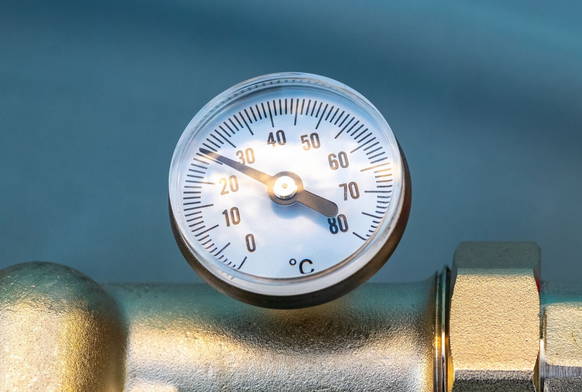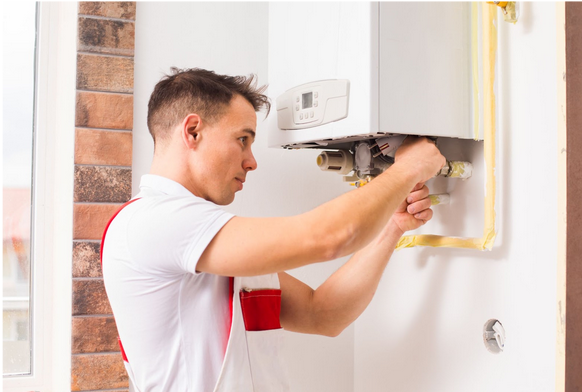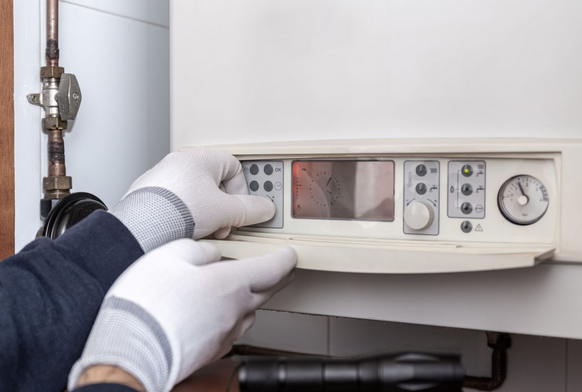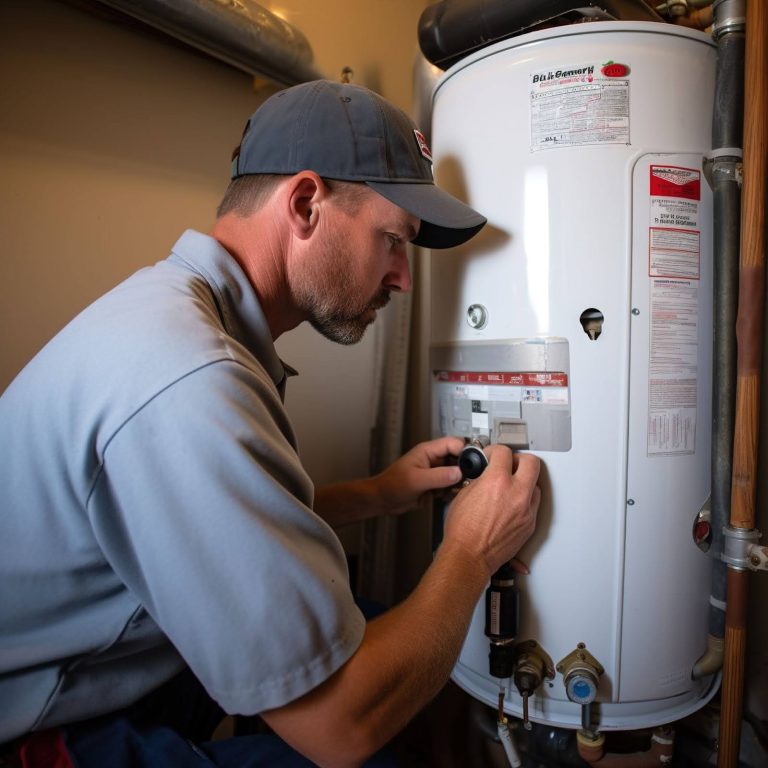The notorious F1 fault stems from low water pressure within your heating system – a common yet fixable issue that has homeowners scrambling for their user manuals or speed-dialling experts like me.
In this article, we’ll delve into simple solutions you can safely attempt and when it’s time to pass the baton to Gas Safe professionals.

Key Takeaways
- The F1 error code on an Ideal boiler signals low water pressure, which you can often fix by repressurising the system using the filling loop.
- Regular checks for leaks in radiators and pipes plus servicing by a Gas Safe engineer can prevent problems like F1 codes from happening.
- If your boiler’s pressure gauge reads below 1 bar or strange noises come from radiators, it may be time to add water or bleed the radiators to raise the pressure.
- A faulty pressure sensor could also cause an F1 error; if simple fixes don’t work, you’ll need a professional to replace it accurately.
- Always call a qualified Gas Safe registered heating engineer when in doubt about fixing your boiler error codes to avoid bigger issues.
Understanding the F1 Error Code on a Boiler
The F1 error code on a boiler is like a cry for help. It pops up when there’s not enough water pressure in the system. Your boiler needs the right amount of pressure to send hot water around your home smoothly.
The pressure gauge can give you a clue about what’s happening – if it reads too low, that F1 message might show up.
Leaks are another troublemaker for boilers, causing that same pesky F1 code to flash on the display. They let water escape from your central heating system, dropping the pressure and disrupting your cosy home vibe.
Keep an eye out for puddles or damp spots near your boiler or radiators; they’re telling signs of sneaky leaks looking to stir up trouble with your heating.
Causes of the F1 Error
Low water pressure, faulty pressure sensors, and leaks in the central heating system can all lead to the F1 error code on a boiler. Understanding these causes is crucial for effective troubleshooting.
Low Water Pressure
Your boiler might show an F1 error if the water pressure is too low. This means there’s not enough water flowing through the system to heat your home properly. To fix it, you usually need to repressurise the boiler using the filling loop.
A simple check can show if this is needed: just take a look at the boiler pressure gauge. If it’s below 1 bar, your system needs more water.
Sometimes you’ll hear strange noises like bangs or whistles from the radiators when pressure is low. These sounds mean air has gotten into the system and could be stopping hot water from moving freely.
Bleeding radiators get rid of trapped air and help raise pressure levels back to where they should be. Remember, keeping an eye on your boiler’s pressure can stop small issues from turning into big problems later on.

Faulty Pressure Sensor
Another reason for the F1 error could be a damaged pressure sensor. This part of your boiler keeps tabs on water pressure levels, ensuring they stay safe and steady. If the sensor stops working properly, it might wrongly signal that there’s low pressure when everything is okay.
Or it could miss a real drop in pressure, leading to trouble with heating and possible damage to the boiler. Regular checks by a gas safe registered heating engineer can catch sensor issues early before they cause bigger problems.
A heating engineer can replace a faulty sensor with precision and care, helping prevent those pesky F1 alerts from popping up again.
Leaks in Central Heating System
Water leaks in your central heating system can be a real headache. They often lead to the dreaded F1 error code on an Ideal boiler. These pesky leaks cause water pressure to drop, which the boiler needs to function properly.
Detecting and fixing these leaks is key to getting your heat back up and running.
Check all pipes, radiators, and connections for signs of leaking water. Sometimes you might find damp patches or hear dripping sounds if there’s a leak. Fix any leaks quickly to stop that F1 error from popping up on your boiler’s display.
Regular checks could save you time and keep your heating system healthy.
How to Fix the F1 Error
Your boiler needs the right water pressure to work well. If the F1 error shows up, check if the boiler’s pressure gauge is too low. This gauge usually sits on the front of your boiler.
It should read between 1 and 2 bars when everything’s good.
If it’s under 1 bar, your heating system lacks pressure and you must add more water through a filling loop to fix it. Find this loop beneath or near your combi
boiler; it’s a flexible metal hose with small valves at each end.
Open these valves carefully and watch as the pressure rises on the gauge. Close them as soon as it hits over 1 bar to stop more water from going in.
Make sure you don’t pump too much into the system though – high pressure can lead to other problems!

Adjusting the Water Pressure
Once you’ve checked the boiler’s water pressure, it may be time to adjust it if it’s too low. To fix the F1 error, you’ll often need to repressurise your boiler. This is done using the filling loop, which adds water to your heating system.
Make sure you turn off the boiler before starting.
Turn the valve slowly on the filling loop until the pressure gauge moves into the green zone, usually between 1 and 1.5 bars. Don’t add too much water – this could raise the pressure too high.
After adjusting, check for leaks in your central heating system as they might cause a pressure drop again. Regular checks help keep your boiler running smoothly and efficiently.
Regular Boiler Servicing
Getting your boiler checked often can stop troubles in their tracks. A skilled heating engineer examines the heat exchanger, thermostat, water supply, and more during a service visit. They make sure everything’s working right and fix small issues before they grow big.
This helps you save energy and money in the long run. Boiler maintenance is key to keeping your heating system pumping out warmth without hiccups or huge repair bills later on.
Book a service yearly to keep your boiler healthy. The engineer cleans parts, checks for leaks, and tests safety devices during this check-up. This isn’t just about preventing breakdowns; it ensures that you meet terms laid out by the Financial Conduct Authority too if you’re under certain agreements related to your home heating setup.
Regular servicing keeps everything legal, efficient, and reliable so you’re not left cold when it matters most.
Understanding Different Boiler Error Codes: From F1 to F75
Deciphering error codes on your boiler is key to troubleshooting issues that might arise. Here’s a quick guide to some common Ideal boiler error codes ranging from F1 to F75, encapsulated in an HTML table to help you identify and understand what your boiler might be trying to tell you:
| Error Code | Meaning | Possible Solution |
|---|---|---|
| F1 | Low Water Pressure | Check and repressurise the system. |
| F2 | Flame Loss | Reset the boiler or check for obstructions. |
| F3 | Fan Fault | Inspect the fan for faults or obstructions. |
| F4 | Flow Thermistor Issue | Test the thermistor, and replace if necessary. |
| F5 | Return Thermistor Issue | Check connections or replace the thermistor. |
| F6 | Outside Sensor Failure | Ensure the sensor is correctly installed or replaced. |
| F7 | Low Mains Voltage | Investigate power supply issues. |
| F9 | Unconfigured PCB | Reset or replace the printed circuit board. |
| F12 | Communication Error | Check wiring or PCB connections. |
| F13 | PCB Fault | Inspect PCB and replace if faulty. |
| F25 | Flow and Return Thermistor Difference | Look for circulation problems or blockages. |
| F28 | Flame Detection Fault | Examine flame detection components. |
| F75 | Pump Water Shortage | Check pump operation and pressure sensors. |
When to Call a Professional for F1 Error
If you notice the F1 error on your boiler and have already checked and adjusted the water pressure, it’s time to call a qualified Gas Safe engineer. A professional should be contacted if there are hidden leaks in the central heating system or if the pressure sensor needs repairing.
Ignoring the need for professional help could lead to more severe issues, such as needing to replace the entire boiler, which can be expensive. It is important to address this error promptly with expert assistance.
Yes! It’s Fixed!
Understanding the F1 error code on a boiler is crucial for maintaining its efficiency. Addressing low water pressure by repressurising the boiler through the filling loop can efficiently resolve this issue.
Neglecting to fix the F1 error code could lead to greater expenses and more problems, emphasising the importance of timely action. Regular maintenance and servicing are essential in preventing heating system problems and ensuring long-term efficiency and cost-effectiveness.
By taking practical steps such as fixing leaks, increasing boiler pressure, and resetting the boiler, homeowners can ensure their boilers continue to function optimally.
























